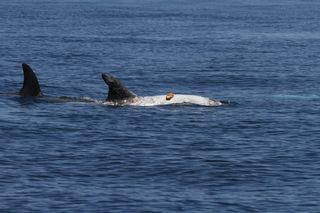
For the second of a planned five summers, a team of researchers is spending a couple weeks in waters off southern California, attaching suction-cup acoustic tags to whales, then playing sounds underwater to see how they respond to different sounds and intensities. Another two weeks of field work will occur in late September. As Brandon Southall notes on his SEAblog, which provides excellent coverage of the trip, the team is “interested in testing the differences in responses of marine mammals in the various kinds of habitats in which they live and are exposed to human sounds.” After several years of study, the research is moving beyond simply getting one or two examples of any given species, toward the development of a wide array of examples of each species, in different circumstances (at least for the easier-to-tag species). The study is known as a Behavioral Response Study (BRS), which used to be called Controlled Exposure Experiments (CEE), with the CEE term still in use as the name of each individual playback to a tagged animal. This year’s southern California version goes by the name of SOCAL-11. The acoustic tags used in the study allow researchers to record the actual sounds heard by the animals (including of course their own foraging and communication vocalizations), while also tracking their swimming speed and dive patterns.
It’s always easier to find and approach the large whales, such as blue and fin whales, so the team tends to focus on these species when waves are higher; in light seas, they are largely seeking the harder-to-locate, and much harder to approach beaked whales, as well as Risso’s dolphins. Here’s a taste of what you’ll find if you follow the study on the SEAblog (the picture above is the animal he’s so enthused about):
Rissos dolphins are among our focal species for SOCAL-11 experiments. We conducted one CEE on this species last year in SOCAL-10 and have been hoping for more this year. This species has also proven somewhat difficult to tag in the past and our tags on last year were for just a few hours, so to get a nine hour deployment spanning several different behavioral modes was pretty exciting. The tag came off late into the evening, but quite close to our anchorage and we made a beautiful late night ride in very calm seas and a red-yellow moon out to safely retrieve it.
In addition to increasing the data set of carefully measured behavioral responses to sound, the researchers are testing two leading-edge technologies: a next-generation acoustic tag, and a towed hydrophone system deployed from a sailboat that’s being used to try to find animals for possible tagging by hearing them from afar. Plus, associated research is underway, including a study of the prey and oceanographic conditions around tagged animals, which aims to learn something about how the ocean conditions relate to where the prey is, and thus where the whales are, as well as to see whether behavior in response to sound is different when prey is present or not.
You can learn more about the SOCAL BRS study, including powerpoints describing last year’s findings, at the SOCAL-BRS web page. Or, get more current updates by following the study on the SEAblog, or on the SOCAL-11 Facebook page (which includes some videos):
